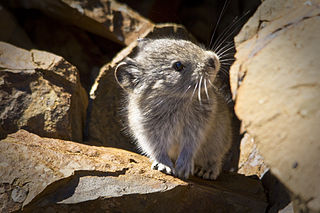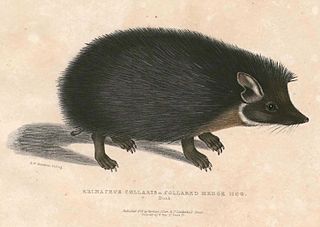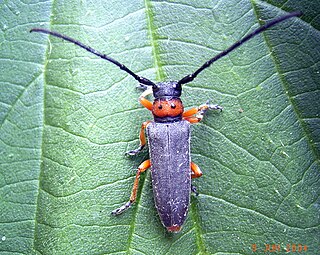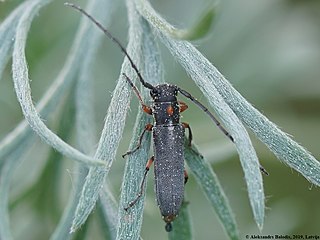
The ring-necked duck is a diving duck from North America commonly found in freshwater ponds and lakes. The scientific name is derived from Greek aithuia, an unidentified seabird mentioned by authors including Hesychius and Aristotle, and Latin collaris, "of the neck" from collum, "neck".

The alpine accentor is a small passerine bird in the family Prunellidae, which is native to Eurasia and North Africa.

The collared trogon is a near passerine bird in family Trogonidae, the quetzals and trogons. It is found in Mexico, throughout Central America, and in northern South America.

The common collared lizard, also commonly called eastern collared lizard, Oklahoma collared lizard, yellow-headed collared lizard, and collared lizard, is a North American species of lizard in the family Crotaphytidae. The common name "collared lizard" comes from the lizard's distinct coloration, which includes bands of black around the neck and shoulders that look like a collar. Males can be very colorful, with blue green bodies, yellow stripes on the tail and back, and yellow orange throats. There are five recognized subspecies.

The collared pika is a species of mammal in the pika family, Ochotonidae, and part of the order Lagomorpha, which comprises rabbits, hares, and pikas. It is a small alpine lagomorph that lives in boulder fields of central and southern Alaska (U.S.), and in parts of Canada, including northern British Columbia, Yukon, and western parts of the Northwest Territories. It is closely related to the American pika, but it is a monotypic form containing no recognized subspecies. The name comes from distinctive patches of grayish fur on its nape and shoulders that form a “collar.” It is asocial, does not hibernate, and spends a large part of its time in the summer collecting vegetation that is stored under rocks ("haypiles") as a supply of food for the winter. Some individuals have been observed collecting and consuming dead birds as sources of fat and protein. Thousands of trips are made during July and August to collect vegetation for winter.

The Indian long-eared hedgehog is a small species of mammal native to northern India and Pakistan. It is insectivorous and nocturnal.

The greater hog badger is a very large terrestrial mustelid native to Southeast Asia. It is listed as Vulnerable in the IUCN Red List of Threatened Species because the global population is thought to be declining due to high levels of poaching.

Phytoecia is a genus of longhorn beetles of the subfamily Lamiinae,
Phytoecia gianassoi is a species of beetle in the family Cerambycidae. It was described by Sama in 2007 and later reclassified to the subgenus Coptosia within the genus Phytoecia.

Phytoecia puncticollis is a species of beetle in the family Cerambycidae. It was described by Faldermann in 1837. It is known from Russia, Azerbaijan, Georgia, Iraq, Armenia, Turkey, Iran, and Turkmenistan. It feeds on Eryngium billardierei.
Phytoecia gaubilii is a species of beetle in the family Cerambycidae. It was described by Mulsant in 1851. It is known from Tunisia and Algeria.

Phytoecia comes is a species of beetle in the family Cerambycidae. It was described by Henry Walter Bates in 1884. It is known from Taiwan, Myanmar, North Korea, South Korea, China, Vietnam, and Japan.
Phytoecia humeralis is a species of beetle in the family Cerambycidae. It was described by Waltl in 1838, originally under the genus Saperda. It is known from Palestine, Greece, Georgia, Iran, Azerbaijan, Syria, Cyprus, and Turkey. It feeds on Silybum marianum.
Phytoecia millefolii is a species of beetle in the family Cerambycidae. It was described by Adams in 1817, originally under the genus Saperda. It has a wide distribution between Europe and the Middle East.

Phytoecia affinis is a species of beetle in the family Cerambycidae. It was described by Harrer in 1784, originally under the genus Leptura. It has a wide distribution in Europe.

Phytoecia caerulescens is a species of beetle in the family Cerambycidae. It was described by Scopoli in 1763, originally under the genus Leptura. It has a wide distribution in Europe, and has been introduced into Australia. It feeds on Echium vulgare, Lappula squarrosa, Anchusa officinalis, Lithospermum officinale, and Cynoglossum officinale.

Phytoecia caerulea is a species of beetle in the family Cerambycidae. It was described by Scopoli in 1772, originally under the genus Leptura. It has a wide distribution in Europe.

Phytoecia pustulata is a species of beetle in the family Cerambycidae. It was described by Schrank in 1776, originally under the genus Cerambyx. It has a wide distribution throughout Europe and the Middle East.
Phytoecia hirsutula is a species of beetle in the family Cerambycidae. It was described by Frölich in 1793, originally under the genus Saperda. It has a wide distribution between Europe and the Middle East.













